
The Solar-Terrestrial Centre of Excellence (STCE) is a collaborative network of the Belgian Institute for Space Aeronomy, the Royal Observatory of Belgium and the Royal Meteorological Institute of Belgium.
 |
Published by the STCE - this issue : 25 May 2012. The Solar-Terrestrial Centre of Excellence (STCE) is a collaborative network of the Belgian Institute for Space Aeronomy, the Royal Observatory of Belgium and the Royal Meteorological Institute of Belgium. |
| Archive of the newsletters | Subscribe to this newsletter by mail |
On Monday May 21, between 00:10 and 03:36 Belgian time, the shadow of the Moon swept over the Earth. An observer in this shadow band could see for several minutes the Sun partially covered by the Moon. If you were in the center of the shadow band, you could watch an annular eclipse: the Moon covers the solar disk, but not completely; the outer ring of the solar disk will still be visible. In Belgium, we were not able to watch the solar eclipse since the Moon’s shadow did not pass over Belgium. It was night time and we were on the backside of the Earth at the time of the eclipse.
But, PROBA2, an ESA micro-satellite with Belgian instruments onboard observed the solar eclipse, up to 4 times! PROBA2 circles Earth in 100 minutes and passes 4 times through the shadow. SWAP, an EUV camera onboard PROBA2 filmed the solar eclipse 4 times. PROBA2 flies at a height of 700 km above the Earth’s surface. This enables the satellite to have an earlier glimpse of the solar eclipse: SWAP saw the first contact on Sunday May 20 at 23:09 Belgian Time. The last contact finished on Monday May 21, 05:04 Belgian Time.
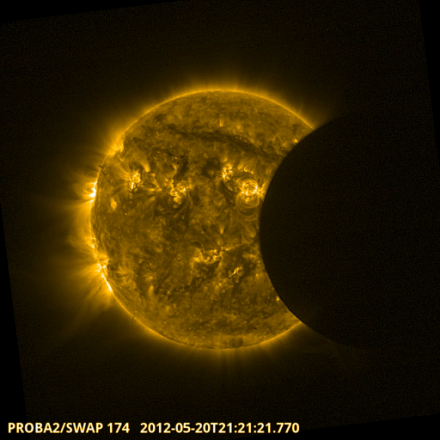
Apart from the science aspect, the solar eclipse gives the PROBA2 researchers the opportunity to characterize the pixels of the EUV-camera. The places where the lunar disk covers the Sun, should give a black EUV image. But scattered light and noise can lighten up a pixel. The solar eclipse will help to determine how good or how bad a pixel is performing. LYRA measures in 4 band passes measuring irradiance from the photosphere up to the corona. The signal becomes less intense during an eclipse as part of the solar radiation is blocked by the Moon. But the decrease and afterwards the increase is not always symmetric as you would expect: active regions contribute the most to the coronal signal and they are not spread symmetric over the solar disk.
The simulation shows the Sun, a yellow ball and the Moon, a red ball. The animation is a nice exercise to model the orbit and the relative positions of the sky bodies.
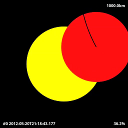
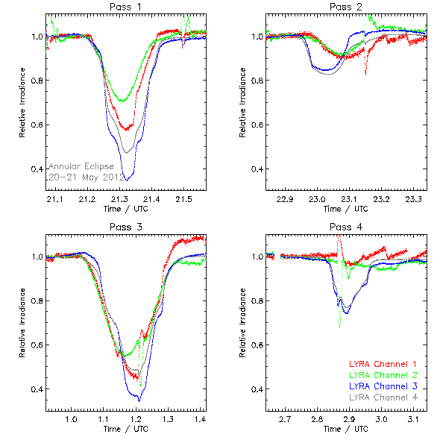
The differences between the longer-wavelength observations (channels 1 and 2, ultraviolet radiation) and the shorter-wavelength observations (channel 3 and 4, extreme ultraviolet [EUV] and soft X-ray [SXR] radiation) demonstrate the inhomogeneous distribution of EUV and SXR radiation across the solar surface. This is especially visible in passes 2 and 4, where the solar disk is hardly touched, but the off-disk active regions are significantly covered by the lunar disk (compare SWAP movie).
Channels 1 and 2 have degraded to such a degree that they are extremely sensible to artifacts like the regular spacecraft rotations or temperature changes, i.e. the data must be interpreted carefully.
SWAP is designed by the Centre Spatiale de Liège, CSL. The Royal Observatory of Belgium takes care of the operational activities. SWAP is an Extreme Ultraviolet solar telescope onboard of PROBA2. The instrument pictures the explosive and dynamical atmosphere, the corona, of the Sun.
LYRA is a solar X-ray and UV filter photometer, designed and manufactured by a Belgian–Swiss consortium. It monitors the solar irradiance in four passbands relevant to Solar Physics, Space Weather and Aeronomy.
The PROBA2 Science Center (P2SC), headquartered at the Royal Observatory of Belgium, handles all aspects of mission science planning and instrument commanding for SWAP and LYRA as well as processing and distribution of all SWAP and LYRA science data.
From 1896 to 1917, the Norwegian physicist Kristian Birkeland designed an experiment called the Terrella. The experiment helped him to understand polar light. He placed a magnetised sphere in a vacuum chamber. With an electron gun, electrons were shot on the sphere. The gun was the Sun and the sphere represented the Earth. Birkeland saw a light ring near the poles and the equator. Later on, the light ring near the equator was identified as a ring current discovered by James Van Allen.
A century later, the Terrella experiment was redefined by Jean Lilensten, Research Director at the Institute of Planetology and Astrophysics in Grenoble. The new design demonstrates aurora, but can simulate also the interaction between other stars and planets. The experiment is now re-baptized as the Planeterrella.
With the help of Jean Lilensten, the STCE, BIRA-IASB and the ROB is now building its own planeterrella experiment. Planeterrella enthusiasts met on a regular basis to discuss and dream about what could be possible with our own planeterrella. Our planeterrella needed to be mobile, easy to operate, with a flexible and adaptable configuration, save for the operator and audience and of course, budget friendly but above all, a tool for various scientific experiments.
We want our planeterrella to serve educational but also scientific purposes. STCE scientists want to check if the measured polarization of the emitted light fits the theory. Besides the visible light, UV radiation will also be emitted. The experiment will also allow us to check the degradation of filters caused by UV-radiation. The planeterrella represents a beautiful and accessible introduction to space science and space weather. Class room experiments can also be done with it: measuring the UV transmission and compare it with the UV radiation outside - to check if it the experiment is a threat for your health or not.
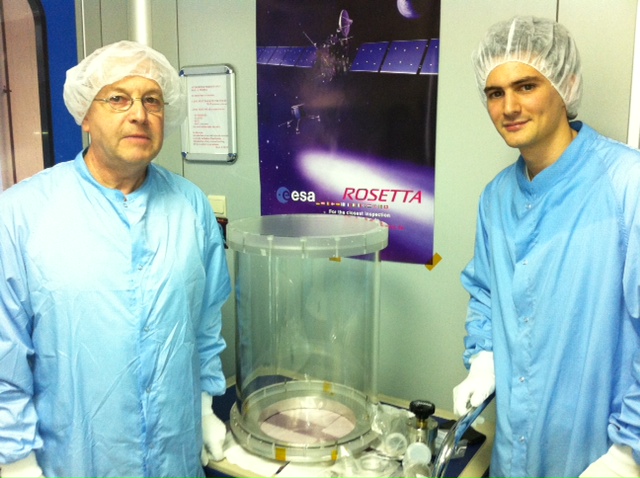
Several M-flares were produced from Monday May 7 till Thursday May 10. NOAA AR 1471 was active in the beginning of the period (M1.9 flare on May 7) but most flaring and the largest flare of the period (M5.7 on May 10) was produced by NOAA AR 1476. After that, flaring activity decreased although NOAA AR 1476 retained a beta-gamma-delta configuration till the end of the period.
The ACE low energy proton fluctuated since May 11 suggesting that the Earth environment was magnetically connected to NOAA AR 1476 in the second half of the period. Nevertheless, the NOAA GOES proton event threshold was not reached during the period.
On May 17, we had a moderate revival: one M-class flare was detected, an M5.1 event peaking at 01:47 UT, again from NOAA AR 1476. This flare was related to a proton event and a CME with an Earth directed component and type II and III radio bursts. During the following days, only minor C-class flares were monitored.
Enhanced geomagnetic conditions were observed on May 9 and May 10. KDourbes, as well as NOAA's planetary K-index registered K=4 values. This enhanced activity was a consequence of a coronal hole passing the solar central meridian. The solar wind speed, as recorded by the ACE spacecraft at L1, gradually rose from 300km/s to nearly 700 km/s with intermittent episodes in which the Bz component of the interplanetary magnetic field turned southwards.
On May 15 an ICME arrived on Earth, most probably coming from an eruption on May 12, but did not cause any geomagnetic consequences. On May 20 at 01:44 UT a shock coming from the CME on May 17 was detected at ACE, without geomagnetic consequences (it produced active conditions at planetary levels Kp=4, but only k=2 at Dourbes).
| DAY | BEGIN | MAX | END | LOC | XRAY | OP | 10CM | TYPE | Cat | NOAA | NOTE |
| 7 | 1403 | 1431 | 1452 | S19W46 | M1.9 | 1N | 230 | IV/1 | 1471 | observed by PROBA2/SWAP | |
| 8 | 1302 | 1308 | 1312 | N13E44 | M1.4 | 1F | 69 | 1476 | |||
| 9 | 1221 | 1232 | 1236 | N13E31 | M4.7 | 1N | 110 | 1476 | |||
| 9 | 1402 | 1408 | 1414 | N06E22 | M1.8 | 1B | 68 | III/2 | 1476 | ||
| 9 | 2101 | 2105 | 2109 | M4.1 | 240 | 1476 | |||||
| 10 | 0411 | 0418 | 0423 | N13E22 | M5.7 | 2B | 690 | III/2 | 1476 | ||
| 10 | 2020 | 2026 | 2030 | N12E12 | M1.7 | 100 | 25 | 1476 |
| LOC: approximate heliographic location | TYPE: radio burst type |
| XRAY: X-ray flare class | Cat: Catania sunspot group number |
| OP: optical flare class | NOAA: NOAA active region number |
| 10CM: peak 10 cm radio flux |
| DAY | BEGIN | MAX | END | LOC | XRAY | OP | 10CM | TYPE | Cat | NOAA | NOTE |
| 17 | 0125 | 0147 | 0214 | N11W76 | M5.1 | 1F | 540 | II/3 IV/2 III/3 | 1476 |
| LOC: approximate heliographic location | TYPE: radio burst type |
| XRAY: X-ray flare class | Cat: Catania sunspot group number |
| OP: optical flare class | NOAA: NOAA active region number |
| 10CM: peak 10 cm radio flux |
This week, the Sun’s activity was low to moderate. An M-flare occurred on Thursday 17th, 01:25 (see below).
M5.1 Flare - West limb, 17/05 @ 01:25 - normal SWAP image
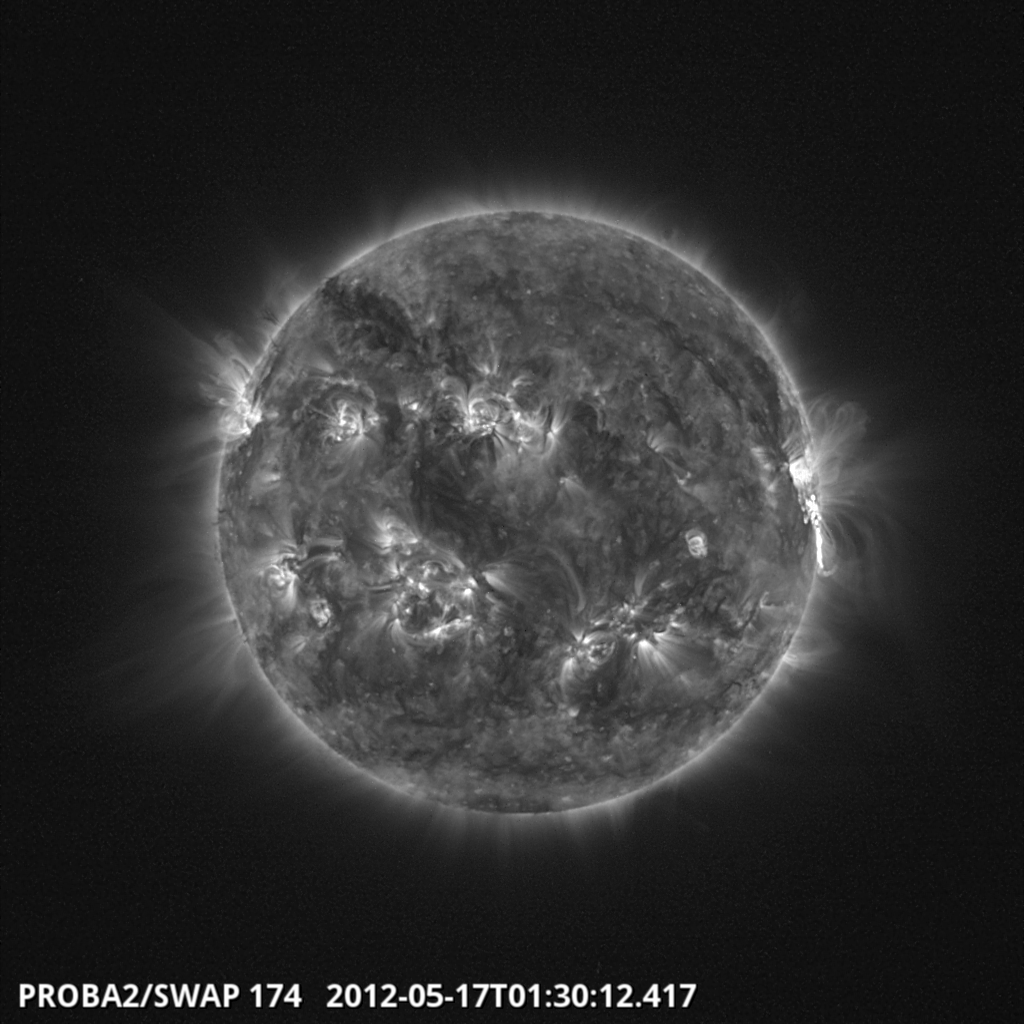
M5.1 Flare - West limb, 17/05 @ 01:25 - LYRA curves
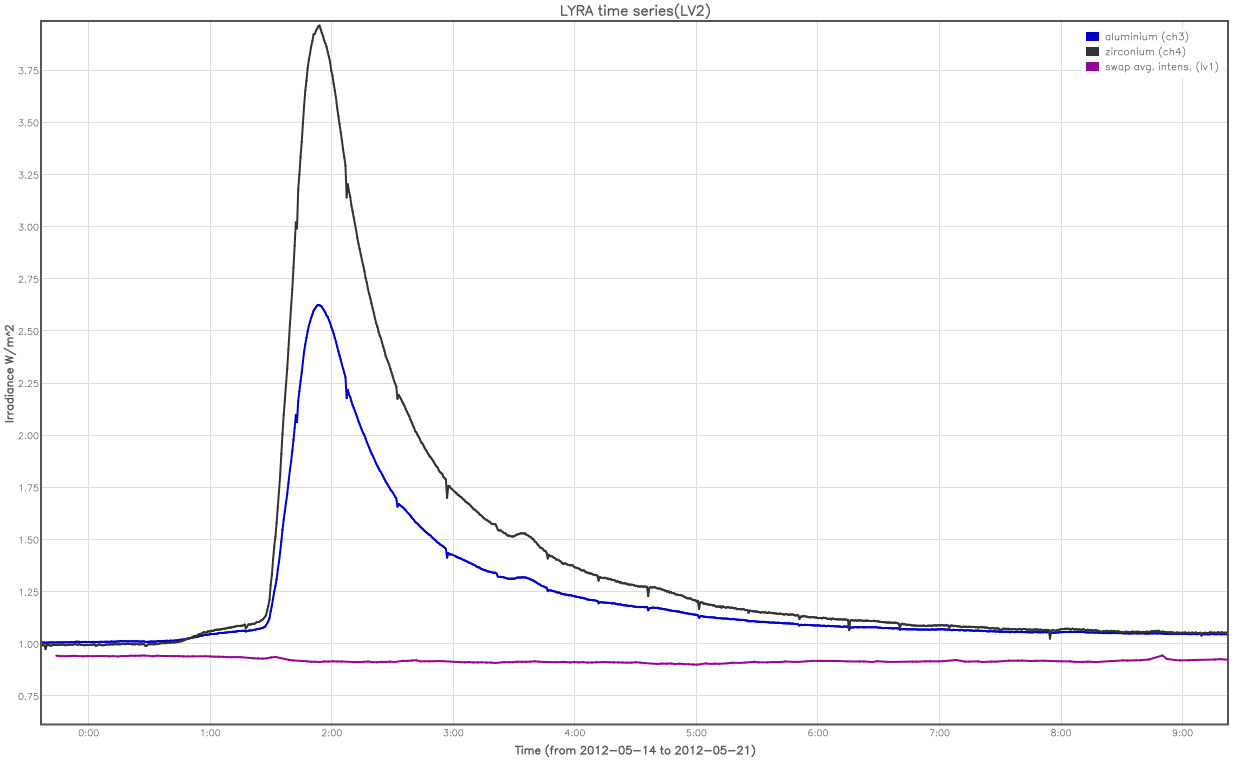
This event can be seen in its totality in a difference movie here: http://proba2.oma.be/swap/data/mpg/movies/20120517_swap_diff_extract.avi
Solar Eclipse:
From Sun 20th to Mon 21st, an annular solar eclipse occurred (as seen from ground).
SWAP and LYRA were prepared to gather data during this specific event.
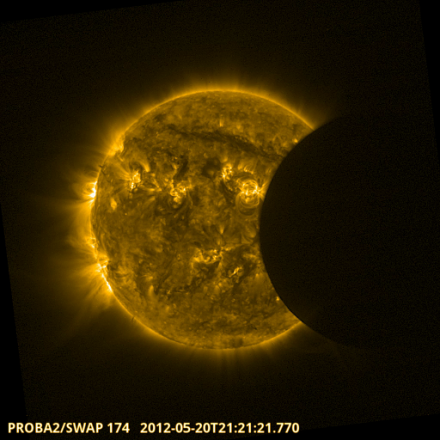
A SWAP movie of this occurrence (4 eclipses!) can be seen here:
http://proba2.sidc.be/swap/data/mpg/movies/campaign_movies/20120520_eclipse.mp4
The associated LYRA curves - as well as the dips in the mean solar intensity (SWAVINT; in purple) - are shown below:
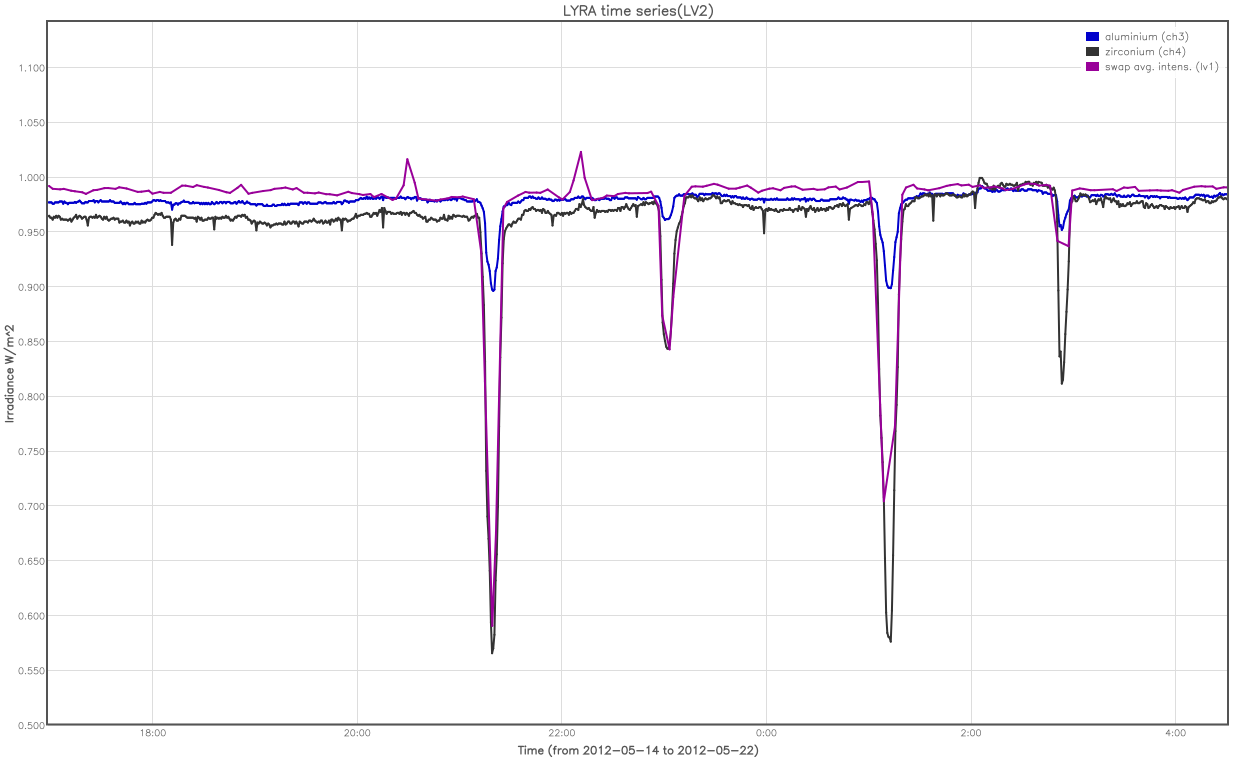
At the occasion of the solar eclipse of Sunday 20th/Monday 21st, a press release was released by the Royal Observatory of Belgium. The release can be found here:
http://proba2.oma.be/index.html/outreach/breve/solar-eclipse-20-21-may-2012
SWAP’s movie of the eclipse has been noticed on the following public webpages:
http://www.spacedaily.com/reports/Proba_2_catches_solar_eclipse_999.html
http://www.youtube.com/watch?v=Ybzkl5enXQo
http://news.softpedia.com/news/Proba-2-Catches-Sunday-s-Solar-Eclipse-270841.shtml
http://www.flickr.com/photos/europeanspaceagency/7240932650/
http://digg.com/news/science/proba_2_catches_solar_eclipse
http://astronews.skynetblogs.be/archive/2012/05/21/proba-2-attrape-l-eclipse-solaire.html
http://pgj-new.pagesperso-orange.fr/0512-nouvelles.htm#Proba-2
https://plus.google.com/100720077817157516563/posts/EZRcaE733ao
http://www.portaltotheuniverse.org/news/view/196142/
http://www.onenewspage.co.uk/n/Science/74r8tfcyr/Proba-catches-solar-eclipse.htm
http://spacefinalfrontier.blogspot.com/2012/05/proba-2-observes-solar-eclipse.html
http://inagist.com/all/204532587702665216/
http://www.space.com/15797-solar-eclipse-satellite-pictures.html
http://redux.com/stream/item/2264663/Proba-2-Catches-Solar-Eclipse
http://www.lalibre.be/archives/divers/article/739215/breves.html
In addition, the NASA SDO page on Facebook referenced to the PROBA2 movie..
Also, the P2SC web page with the eclipse movie was mentioned on various Facebook pages (astro/solar photography).
Start : 2012-05-31 - End : 2012-06-07
The 2012 Heliophysics Summer School will focus on the science
underlying current and future heliophysical missions, including but
not limited to MMS, Themis
, RBSP, IRIS, SDO, and Solar Probe
Plus. After providing students with broad overviews of the solar
atmosphere, the solar wind
, the Earth's magnetosphere
, and ionosphere
, the course will cover the basic
concepts and unanswered questions pertaining to magnetic
reconnection, shocks, plasma
instabilities, turbulence, and
heating, and the manner in which these concepts and questions
affect our understanding of phenomena such as substorms, radiation
belt and chromospheric dynamics, solar wind
turbulence and particle heating,
and heliospheric shocks.
Link:
http://www.vsp.ucar.edu/Heliophysics/summer-about-over.shtml
Start : 2012-06-04 - End : 2012-07-27
The Los Alamos National Laboratory established a summer school
in 2011 dedicated to space weather
, space science and applications.
Every year we solicit applications for the Los Alamos Space Weather
Summer School. This summer school
is sponsored by IGPP (Institute of Geophysics and Planetary
Physics) and PADSTE (Principal Associate Directorate for Science,
Technology and Engineering), and PADGS (Principal Associate
Directorate for Global Security) and has been established to bring
together top space science students with internationally recognized
researchers at LANL.
Website:
http://www.swx-school.lanl.gov/
Start : 2012-06-04 - End : 2012-06-09
The Space Weather
Integrated Forecasting Framework
network (http://www.swiff.eu) organizes in June 2012 the "First
European School on Fundamental processes in space weather
, a challenge in numerical
modeling". The School will focus on the theoretical study of Space
plasmas, in particular on those systems where a continuous energy
injection flow leads to a self-consistent coupling of the large
scale, low frequency motions with the small scale, high frequency
fluctuations including kinetic effects. Progress in this field
heavily relies on numerical simulations that, as a matter of fact,
are nowadays more similar to laboratory experiments than to
theoretical exercises. This is true in terms of planning efforts in
the preparatory phase, of manpower required, of data analysis and
cost. The understanding of these processes represents a fundamental
step for the future of Space Weather
models.
Website:
http://www.df.unipi.it/~califano/SWIFF_School/EU_School_on_Space_Weather_fundamental_plasma_processes.html
Start : 2012-06-04 - End : 2012-06-08
During the last thirty years there has been steady progress in
our understanding of the influence that space weather
has on the state of human health
both in Space and at Earth. This development is mainly based on
research conducted on humans onboard space stations and
spacecrafts, as well as on ground based observations and
experimental studies simulating conditions in space. This
interdisciplinary field of research requires a wide exchange of
expertise in various topics. Only with a global approach it will be
possible to establish a mutual understanding, in regard to defining
the current state of this research problem as well as identifying
what should be pursued in future research activities.
Website:
http://swh2012.cosmos.ru/
Start : 2012-06-06 - End : 2012-06-10
We announce the 'Second Remote Sensing of the Inner Heliosphere
Workshop' to be hosted by
Aberystwyth University and held in Aberystwyth, Wales, UK, 06-10
June 2011. The workshop aims to gather experts from the various
fields of remote-sensing observations of the inner heliosphere
, including white-light, EUV, and
radio observation, together with modellers in order to tackle key
outstanding science issues, establish closer working relations, and
devise the best ways to move the field forward. In addition, the
science learned from remote-sensing observations is key to
improving our capabilities of space weather
forecasting. The workshop also aims
to look at ways in which we can more easily and efficiently share
and access the various types of data between individual groups and
sub-communities, ways in which we model the inner heliosphere
looking at the advantages and
disadvantages of the available modelling, updates on present and
future remote-sensing capabilities - including those on the STEREO
/SDO/Solar Orbiter/Solar Probe+
Missions, and progress on use of the LOw Frequency ARray (LOFAR)
and Murchison Widefield Array (MWA) radio arrays - pathfinders for
the Square Kilometre Array (SKA) - linking remote-sensing
observations of the inner heliosphere
with those closer-in to the Sun as
well as with in-situ measurements, and investigating further the
ways in which these data sets all complement each other and are
necessary to gain knowledge and understanding of the fundamental
physical processes that occur within the inner heliosphere
.
Website:
http://heliosphere2011.dph.aber.ac.uk/
Start : 2012-06-17 - End : 2012-06-22
The Thirteenth International Solar Wind
Conference, organized by the
University of Alabama in Huntsville's Center of Space Plasma
and Aeronomic Research (CSPAR) and
the the University of California, Berkeley's Space Sciences
Laboratory, will take place at Sheraton Keauhou Resort on Big
Island, Hawaii, USA, from 17 to 22 June 2012. Please note that
scientific sessions will start on Monday 18 June.
The conference will conform to the traditional solar wind
themes, addressing the current
state of knowledge in the relevant fields of solar and heliospheric
physics. In particular, the conference will focus on the physics
ofthe corona, the origin and acceleration of the solar wind
, its dynamical interactions
throughout the heliosphere
and the interstellar medium and its
boundaries. The program will be composed of both invited lectures
and contributed talks and posters.
Website: http://www.sw13.org/
Start : 2012-06-25 - End : 2012-06-29
SHINE stands for Solar Heliospheric and INterplanetary
Environment. It is an affiliation of researchers within the solar,
interplanetary, and heliospheric communities, dedicated to
promoting an enhanced understanding of the processes by which
energy in the form of magnetic fields and particles are produced by
the Sun and/or accelerated in interplanetary space and on the
mechanisms by which these fields and particles are transported to
the Earth through the inner heliosphere
.
SHINE research focuses in particular upon the connection between
events and phenomena on the Sun and their relation to solar wind
structures in the inner heliosphere
. The goal of SHINE activities is
to enrich and strengthen both physical understanding and predictive
capabilities for these phenomena.
Website:
http://shinecon.org/Current%20Meeting.htm
Start : 2012-06-25 - End : 2012-06-28
Toulouse will host the most important players in the global
aerospace industry, particularly those focusing on space
applications. It will provide the opportunity to meet with more
than 1000 experts, service providers, clients, users, researchers
and students from all over the world.
Website:
http://www.toulousespaceshow.eu/tss12/en/
Start : 2012-07-01 - End : 2012-07-06
We have the pleasure to invite you in July 2012 to attend the
European Week of Astronomy and Space Science, the now classical
Ewass meeting, formely known as Jenam. In 2012, the meeting will
take place in Rome, Italy, at the Pontificia UniversitÃ
Lateranense.
Website:
http://www.ifsi-roma.inaf.it/ewass2012/
Start : 2012-07-03 - End : 2012-07-19
The Sun is our closest and most well studied celestial object.
From the beginnings of human civilizations, the Sun has played a
major role in their development, and in the rituals and customs
that can still be perceived in the modern world. Unprecedented
advances and new missions have revealed the real complexity of the
Sun. New missions like SDO, SolarProbe Plus and other satellite
missions (RHESSI, SOHO
, TRACE
, YOHKOH
, etc.) provide information that
may help to unveil the secrets of our star
. The Observatorio Astronomico
Nacional and the Universidal Nacional de Colombia organises an
International Summer School in Solar Physics, with the purpose of
promoting the solar research in Colombia and help in the personal
development of postgraduate students and young postdocs in this
area from other countries.
The International Summer School is intended to provide an
advanced training in the field of solar physics to last year
ungraduate students who are willing to write their final work in
any area of solar physics, postgraduate students, and young
post-docs having already some initial work in the fields of solar
physics.
Website:
http://www.observatorio.unal.edu.co/eventos/solarschool/
Start : 2012-07-03 - End : 2012-07-19
Start : 2012-07-04 - End : 2012-07-07
The Sun is the most important astronomical object for humankind
with solar activity having a direct impact on Earth. From a
fundamental point of view the Sun offers an exceptional physics
laboratory where the interactions of the astrophysical plasma
and the magnetic field can be
studied in detail.
The BUKS workshops on MHD waves and oscillations of the solar
atmosphere is organised by the following research groups from
Belgium, Spain and the UK:
* The Centre for Plasma
Astrophysics, Katholieke
Universiteit Leuven, Belgium
* The Solar Physics & Space Plasma
Research Centre, University of
Sheffield, UK
* The Solar & Magnetospheric Theory Group, University of
St Andrews, UK
* The Centre for Fusion, Space & Astrophysics,
University of Warwick, UK
* The Solar Physics Group, Universitat de les Illes Balears,
Spain
* The Astrophysics Research Centre, Queen's University
Belfast, UK
BUKS2012 will also honour the contributions of Prof Marcel
Goossens to the field of MHD waves and offer an opportunity to
celebrate his 65th birthday.
Website:
https://habu.pst.qub.ac.uk/groups/buks2012/
Start : 2012-07-08 - End : 2012-07-11
The 23rd Annual NASA
Space Radiation Investigators'
Workshop will be held July 8-12, 2012, at the Washington Duke Inn,
Durham, North Carolina. The purpose of this workshop is to provide
an opportunity for active researchers in the NASA
Space Radiation Program to share
the results of their work and to explore new directions for
research that may benefit the NASA
program. The workshop format will
include plenary sessions, poster sessions, and a poster contest to
recognize and honor student investigators. In addition, there will
be special sessions on space physics and technology allowing
opportunities for a comprehensive discussion on NASA's overall
space radiation protection goals.
Principal investigators receiving NASA
funds (including those from the
NASA
/DOE joint program and the NSBRI)
are required to attend; principal investigators funded by the
Department of Energy are strongly encouraged to attend. Although
attendance at the workshop is by invitation only, other scientists
with a legitimate interest in space radiation research are also
welcome. If you wish to attend, please send your requests directly
to
. Requests should be accompanied by an explanation of
your relationship to the Space Radiation Program and the type of
contribution you wish to make.
Website:
http://www.dsls.usra.edu/meetings/radiation2012/
Start : 2012-07-11 - End : 2012-07-15
From 11th-15th of July 2012 international researchers, policy
makers, business leaders and global media will gather in the
Convention Centre in Dublin, Ireland to take part in the
Euroscience Open Forum (ESOF), 2012. A science conference like no
other, ESOF 2012 is unique in representing the largest convergence
of the Sciences, Humanities and Culture in Europe in 2012. Some of
the keynote speakers at ESOF 2012 will include Craig Venter,
Rolf-Dieter Heuer, Charles Bolden, Mary Robinson, and Bob
Geldof.
Website: http://www.esof2012.org/
Start : 2012-07-14 - End : 2012-07-22
The 39th COSPAR Scientific Assembly will be held at the Global
Education Centre, 2 Infosys Training Centre Mysore, Karnataka India
from 14 - 22 July 2012. This Assembly is open to all bona fide
scientists.
Website:
http://www.cospar-assembly.org/
Start : 2012-07-16 - End : 2012-07-27
The CISM Space Weather
Summer School is a 2-week intensive
program targeted to first-year graduate students but also attended
by undergraduates and space weather
professionals. The daily schedule
includes morning lectures, followed by afternoon laboratory
sessions where students further explore the day's topics using
CISM model simulations, observational data, and sophisticated
visualization tools. CISM is making the laboratory materials
publicly available for use by others, for example to supplement
lecture courses or for student independent study. The deadline for
applications is May 1.
Website:
http://www.bu.edu/cism/SummerSchool/overview.html
Start : 2012-07-23 - End : 2012-07-27
The Department of Astronomy and Geodynamics of the University of
Warmia and Mazury (UWM) is hosting the 2012 IGS Workshop.
This workshop will be composed or plenary sessions with invited
oral presentations, and afternoon sessions composed of poster
sessions and IGS Working Group splinter meetings. For this workshop
we are soliciting abstracts for the poster sessions.
The key dates for this workshop are as follows:
* Poster Abstract Submissions: March 25 - April 30, 2012.
* Registration: March 25- May 28, 2012.
* Hotel Reservations: March 25- May 28, 2012.
* Workshop: July 23 - July 27, 2012.
Website:
http://www.uwm.edu.pl/kaig/igs_workshop_2012/
Start : 2012-08-06 - End : 2012-08-10
The IRC's International Radiation Symposium 2012 provides a
forum for the scientific community to exchange recent results and
evolving ideas relevant to many areas of atmospheric radiation.
Quadrennially convened, the IRS assembles a global network of
scientists and students engaged in studies pertaining to the
Earth-atmosphere-Sun system, and encourages international
cooperation in radiation research crucial to understanding and
predicting Earth's dynamic climate and habitability. The IRC
invites you to Berlin and welcomes your participation in this
endeavor.
Website: http://irs2012.org/
Start : 2012-08-13 - End : 2012-08-17
An international body established since 2003, the Asia Oceania
Geosciences Society (AOGS) aims to promote geosciences and advance
its applications for the benefit of humanity in Asia and
Oceania.
Sessions:
* Atmospheric Sciences
* Biogeosciences
* Hydrological Sciences
* Ocean Sciences
* Planetary Sciences
* Solar & Terrestrial Sciences
* Solid Earth Sciences
* Interdisciplinary Working Groups
Website:
http://www.asiaoceania.org/aogs2012/public.asp?page=home.htm
Start : 2012-08-13 - End : 2012-08-16
You will have a noticed the slight re-branding of these
workshops from 'Image' to 'Information' processing. We think it is
time to expand the attention of these workshops to discuss more
generally how information about the Sun can be derived, stored,
shared, transformed and analyzed using appropriate techniques from
many other disciplines. We will still be covering image processing
and computer vision techniques applied to solar physics, but we
will also be including other topics such as machine learning, data
mining and new computing strategies. The re-branding simply
acknowledges and makes explicit what the community has been doing
to determine the physics of the Sun.
Link: http://www.sipwork.org/
Start : 2012-08-14 - End : 2012-08-17
There will be 7 sessions, with 2 invited speakers per session.
The following speakers have been invited to Hinode-6:
Website:
http://www-solar.mcs.st-and.ac.uk/~hinode6/Hinode-6/Welcome.html
Start : 2012-08-20 - End : 2012-08-31
In August 2012 China will for the first time host the General
Assembly of the International Astronomical Union in Beijing. This
triennial gathering of astronomers from around the world to discuss
and debate the most recent discoveries about the universe is an
important part of the vitality of our science. Astrophysics remains
one of the most exciting areas of human endeavor, and the venue of
the Beijing GA will be equally impressive: the new China National
Convention Center that is housed in the Olympic Park in a
beautiful, spacious building and area that is full of amenities for
conference participants and visitors.
The contributions of Chinese astronomy to human knowledge and
our understanding of the cosmos have been of historical
significance, from the earliest to modern times. GA participants
will have an opportunity to experience the wide range of
astronomical activities now taking place in China that include new
projects, facilities, and institutes. They will also report on, and
hear, the latest research results from every field of astronomy. An
exciting scientific programme is being developed that will hold the
interest of everyone. I am pleased to welcome all Union members and
invited guests to join us in Beijing for what will be a memorable
General Assembly.
Website:
http://www.astronomy2012.org
Start : 2012-09-10 - End : 2012-09-14
We are pleased to announce that the fifth Solar Orbiter Workshop
will take place in Brugge, Belgium from Monday September 10 to
Thursday September 13. Friday September 14 will be dedicated to a
Science Working Team (SWT) meeting. The workshop will focus on the
science questions addressed by this exciting and recently approved
mission, which is a partnership between ESA
and NASA
. The scientific synergy of Solar
Orbiter with Solar Probe Plus and other missions will also be
highlighted.
Website:
http://www.stce.be/solarorbiter5/
Start : 2012-09-18 - End : 2012-09-20
In-situ observations by spacecraft provide [note in no
particular order] the ground truth for comparison and constraining
models, have transformed our ideas of the heliosphere
, provide a natural laboratory for
plasma
physics, have challenged our
pre-conceived ideas, and have discovered completely unexpected
phenomena. This workshop will focus on in-situ observations of the
heliosphere
made by the unprecedented suite of
instruments currently returning observations, including the STEREO
spacecraft, near-Earth spacecraft
(ACE,WIND
, SOHO
) and the Voyager spacecraft that
are probing the region approaching the heliopause. It is a follow
on from the ACE/WIND
/STEREO
... workshop held in Kennebunkport
in June 2010. The program will include an overview of recent
results from current missions, invited presentations, and splinter
sessions with a heavy emphasis on discussion. These sessions will
focus on the solar cycle variations, solar wind
, solar energetic particles,
suprathermal ions, coronal and interplanetary transients, and
anomalous and galactic cosmic rays.
Website:
http://stereo.ssl.berkeley.edu/meetings/Sept.2012meeting/
Start : 2012-09-20 - End : 2012-09-23
Every year, the International Meteor
Organization (IMO) organizes the
International Meteor
Conference (IMC). This conference
deals with all aspects of meteor
observation as well as the
underlying physics and is aimed at both amateurs and
professionals.
The International Meteor
Organization (IMO) will hold the
31st annual International Meteor
Conference (IMC) on La Palma,
Canary Islands, Spain, from 20 till 23 September, 2012. The
conference will be organized by the Astro Travels agency in
collaboration with the Cabildo of La Palma island authority which
will sponsor this event.
Website:
http://www.imo.net/imc2012/
Start : 2012-09-24 - End : 2012-09-28
The 21st European Conference on RADIATION AND ITS EFFECTS ON
COMPONENTS AND SYSTEMS will be held in Biarritz, France, on
September 24-28, 2012.
The aim of RADECS conferences is to provide an annual European
forum for the presentation and discussion of the latest advances in
the field of radiation effects on electronic and photonic
materials, devices, circuits, sensors, and systems. The scope of
the conference encompasses technological processes and design
techniques for producing radiation tolerant systems for space,
aeronautical or terrestrial applications, as well as relevant
methodologies for their characterization and qualification. The
conference features a technical program, an Industrial Exhibit, and
one day meeting on ground effects offered on September 24
(RADGROUND). The technical program includes oral and
postersessions.
The areas of interest for contributions to be submitted to
RADECS 2012 include, but are not limited to:
* Basic mechanisms of radiation effects in electronic and
optical materials
* Space, atmospheric and terrestrial environments
* Radiation effects on electronic and photonic devices, circuits
and systems
* Radiation effects on sensors and emerging devices
* Technology and design hardening
* Radiation hardness assurance
* Irradiation facilities and testing
Website: http://radecs2012.org
Start : 2012-10-01 - End : 2012-10-05
At the forthcoming 63rd International Astronautical Congress in
Naples a special session on the theme 'Effects of Space Weather
on GEO
Satellites' will be held as part of
the 25th Symposium on Space Policy, Regulations and Economics.
This session will discuss case histories and mechanisms of
effects of space weather
on GEO
satellites, models for prediction,
and mitigation approaches. We would like to invite you to consider
submitting abstracts for this session.
The call for papers can be found at
The
deadline for abstract submission is 29 February 2012.
http://www.iafastro.org/docs/2012/iac/IAC2012_CallForPapers.
Website: http://www.iac2012.org/
Start : 2012-10-22 - End : 2012-10-24
2012 - 2013 is expected to be years with high solar activity.
This can trigger larger solar storms which can generate geomagnetic
induced currents (GIC
) on the earth. GIC
can affect the normal operation of
specific industrial operations and critical infrastructure (e.g
power grids, telecom, navigation systems, etc).
During space weather
events, like solar storms, electric
currents in the magnetosphere
and ionosphere
experience large variations, which
manifest also in the earth's magnetic field. These variations
induce currents (GIC
) in conductors operated on the
surface of the earth. Electric transmission grids and buried
pipelines are common examples of such conductor systems. GIC
can cause problems, such as
increased corrosion of pipeline steel and may disturb and possible
damaged high-voltage power transformers and it can also have
damaging effects on communication systems, navigation systems and
oil and gas operations.
Vulnerable industries are the oil and gas industry, railways,
telecommunication industry, navigation industry and not at least
the society, which is very vulnerable concerning short or long term
interruption of critical infrastructure.
The conference will focus on increasing the general knowledge of
solar storms, space weather
and GIC
and the possible consequences for
different industries and critical infrastructure, and look into
reasonable means of protection, and consider possible early warning
solutions.
Website:
http://www.tiems.info/about-tiems/oslo-conference-2012.html
Start : 2012-11-05 - End : 2012-11-09
We are pleased to announce that the Ninth European Space Weather
Week will take place at the
Académie Royale de Belgique, Brussels, Belgium between 5
and 9 November 2012.
This meeting is being jointly organised by the Solar-Terrestrial
Centre of Excellence (STCE), ESA
, the SWWT and the COST ES0803
communities. The local organisation is done by the STCE. This event
will continue to build on the advances made during the first eight
European Space Weather
Weeks held between 2004 and
2011.
Website:
http://www.sidc.be/esww9/
Start : 2012-11-06 - End : 2012-11-09
The International Symposium on Solar-Terrestrial Physics will be
held during November 6 - 9, 2012 at the Indian Institute of
Science, Education and Research, Pune, India. This meeting under
the aegis of the SCOSTEP is expected to draw leading scientists
from around the world in the increasingly important,
interdisciplinary fields of Solar activity and its impact on
geospace and life on the Earth. With major observational solar
facilities being planned in India, this meeting is especially
pertinent in the Indian context.
The meeting is expected to involve professional scientists as
well as graduate students, and will have a mixture of invited and
contributed talks and posters. There will also be a one-day
tutorial for the benefit of young people beginning work in the
field of solar-terrestrial physics.
Website:
http://www.iiserpune.ac.in/~isstp2012/
Start : 2012-11-12 - End : 2012-11-16
As we emerge from one of the deepest and longest solar minima on
record, with a new and powerful eye on the Sun -SDO- we invite all
those with an interest is solar activity to gather in beautiful
Palm Cove, Australia to review and assess our current knowledge and
understanding of our magnetic star
, and to experience the awe and
wonder of a total solar eclipse on November 14, 2012.
Website:
http://moca.monash.edu/eclipse/
Start : 2012-11-13 - End : 2012-11-13
For more information:
http://eclipse.gsfc.nasa.gov/OH/OH2012.html#SE2012Nov13T
Start : 2012-11-15 - End : 2012-11-16
The European Commission will organise the 'Let's embrace
space - FP7 Space Conference 2012', in cooperation with the Cypriot
EU Presidency, on 15 and 16 November 2012 in Larnaca, Cyprus.
This scientific conference will present the current status and
results of the 3rd call of FP7 space research, and also discuss
future options for European research in the space field. In doing
so, the conference will aim at demonstrating the evolution and use
of space tools for a sustainable economic and environmental
development in a European and global context.
Website:
http://www.fp7-space.eu/news-119.phtm
Start : 2012-11-20 - End : 2012-11-23
Nobeyama Radioheliograph (NoRH) has been observing the Sun since
1992. This year is the 20th year of science operation. Instruments
are still in good shape and producing images of the Sun every day
with the same quality as the beginning. Due to the nature of the
instrument and long and uniform observations, data can be used for
wide variety of solar physics and also for solar terrestrial
physics. To mark the 20 years of operation, we will organize a
symposium to summarize what has been done with NoRH and to discuss
what we should do in the future. Papers to be presented in the
meeting will be mainly concerned with the results from NoRH and
future plans.
Website:
http://st4a.stelab.nagoya-u.ac.jp/SPRO2012/
Start : 2012-11-30 - End : 2012-12-05
The overarching objective of the conference is to examine the
connections amongst the phenomena that lead to solar eruptive
events. The current state of themes includes:
* Measuring the Coronal Magnetic Field;
* Connections to, and Reactions of, the Large-Scale Corona;
* Large-scale Magnetic Connectivity of Active Regions;
* Transfer of Energy to, and Storage of Energy in, the
Corona;
* The High-Energy Particle - Flare - CME
connection.
Working groups will address topics such as:
* Energy Transfer throughout a Solar Eruptive Event;
* Global Energetics of an Ensemble of Events;
* Coronal Influences to the Lower Atmosphere;
* CME
Initiation and Type II Bursts;
* The Release of Energetic Particles in the Low Corona;
* Flows vs. Waves;
* Microflares/Nanoflares.
Website:
http://hessi.ssl.berkeley.edu/petaluma/index.shtml
Start : 2013-01-13 - End : 2013-01-19
Information coming soon!
Website:
http://sd-www.jhuapl.edu/Aurora/ESSE/index.html
Start : 2013-03-10 - End : 2013-03-15
Spacecraft observations have established that all magnetized
planets in our solar system interact strongly with the solar wind
and possess well-developed
magnetotails. Magnetotails are the site for many dynamic processes
critical to the circulation of mass, energy and magnetic flux. The
great differences in solar wind
conditions, planetary rotation
rates, ionospheric conductivity, and physical dimensions from
Mercury's small magnetosphere
to the giant magnetospheres of
Jupiter and Saturn provide an outstanding opportunity to extend our
understanding of the influence of these factors. Therefore, this
Chapman conference will provide a forum in which various
communities can come together and discuss recent achievements of
observational, theoretical, and modeling studies with the objective
to develop a deeper understanding of fundamental properties and
processes of planetary magnetotails through a comparative
examination.
Start : 2013-05-10 - End : 2013-05-10
For more information:
http://eclipse.gsfc.nasa.gov/SEplot/SEplot2001/SE2013May10A.GIF
Start : 2013-11-03 - End : 2013-11-03
For more information:
http://eclipse.gsfc.nasa.gov/SEplot/SEplot2001/SE2013Nov03H.GIF
Presentation of UNIGRAZ research in the frame of the eHEROES project. Collaborations and cross-disciplinary possibilities.
http://www.spaceweather.eu/en/repository/show?id=179
The Solar-Terrestrial Center of Excellence is a scientific project
which aims at the creation of an international expert center and the
valorization of Solar and Solar-Terrestrial research and services. The
STCE clusters the know-how of 3 Belgian Federal
institutes:Royal Observatory of Belgium ROBRoyal Meteorological Institute RMIBelgian Institute for Space Aeronomy BISAThe STCE is built upon existing experience present in the 3 institutes related to Solar-Terrestrial physics and operates in a strong collaborative spirit within the international
environment: we expect strong benefits from joint work within the
networks
created by ESA (SWWT, SWENET), EU (COST, FP7) and others (ISSI, ...).This document gives the first complete activity report of the STCE, covering the start-up phase 2007-2008.
http://www.spaceweather.eu/en/repository/show?id=14
The report is a compilation of the activities done in 2010 within the frame of the STCE: progress in research, new or up-tuned applications and products, supporting and coordination activities.
http://www.spaceweather.eu/en/repository/show?id=181
The SWWT is a forum open to European experts in space weather applications and related science as well as users of space weather products.
The SWWT investigates space weather applications’ requirements, space weather services and the underpinning research and development. It also advises ESA on strategies and activities related to space weather.
http://www.spaceweather.eu/en/repository/show?id=183
http://www.spaceweather.eu/en/repository/show?id=184
http://www.spaceweather.eu/en/repository/show?id=185